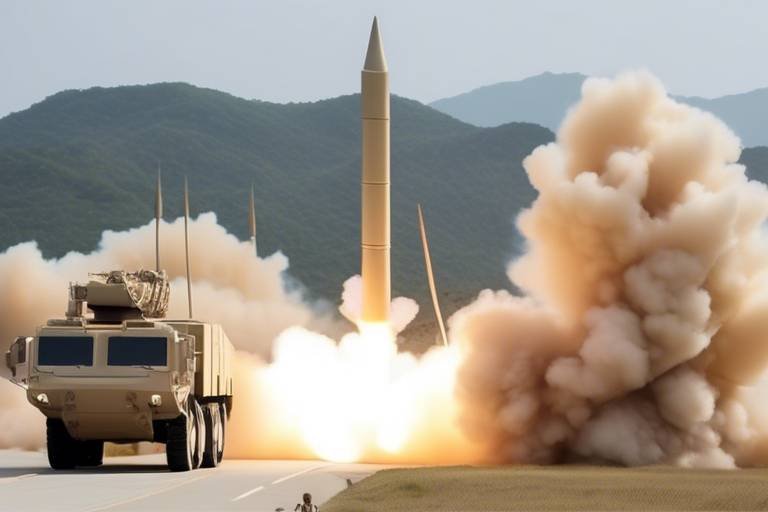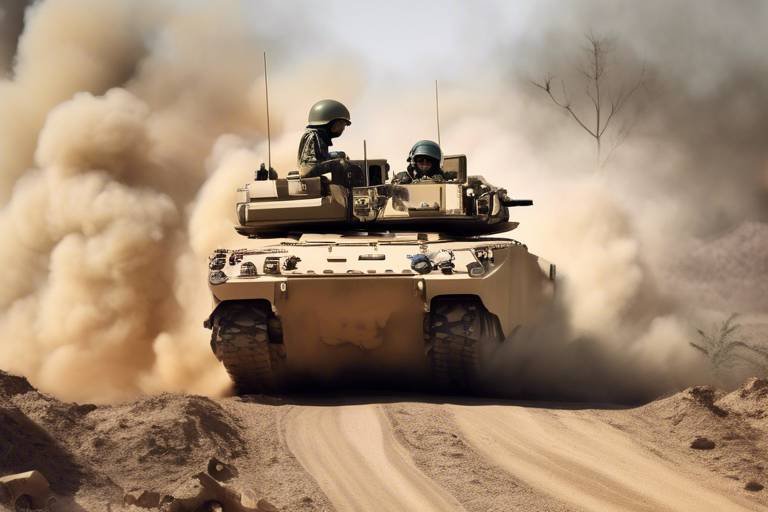The Role of Cyber Resilience in Modern Military Operations
In an era where technology dictates the pace and nature of warfare, cyber resilience has emerged as a cornerstone of modern military operations. Just as a fortress needs walls to protect its inhabitants, military forces today require robust cyber defenses to safeguard their operations from an ever-evolving array of digital threats. The battlefield has expanded beyond traditional fronts and now includes cyberspace, where information warfare can be as devastating as physical confrontations. Understanding the role of cyber resilience in military strategies is not just important; it is essential for maintaining national security and operational effectiveness.
Cyber resilience encompasses an organization’s ability to prepare for, respond to, and recover from cyber incidents. This triad of capabilities ensures that military operations can continue effectively, even in the face of cyber attacks. Imagine a soldier who, despite being under fire, can adapt and find alternative routes to achieve their mission. Similarly, a cyber-resilient military can adjust its strategies in real-time, ensuring that its objectives are met despite potential disruptions caused by cyber threats.
The significance of cyber resilience cannot be overstated. As military operations increasingly rely on advanced technologies and interconnected systems, the potential vulnerabilities multiply. From communication systems to weaponry, every aspect of military infrastructure is susceptible to cyber intrusions. Therefore, establishing a strong foundation of cyber resilience is not merely a technical requirement; it is a strategic imperative that affects the very essence of military readiness and effectiveness.
In this context, the military must not only invest in cutting-edge technology but also foster a culture of awareness and preparedness among its personnel. Training and education play a pivotal role in this transformation, allowing military members to recognize and respond to cyber threats swiftly. The ability to anticipate potential cyber incidents and implement preventive measures can mean the difference between mission success and failure.
Furthermore, collaboration is crucial in building a cyber-resilient military force. Just as a successful military operation often relies on joint efforts across different branches, effective cyber defense necessitates partnerships with private sectors and other governmental agencies. Sharing information and best practices enhances the overall resilience of the military and ensures a united front against cyber adversaries.
As we delve deeper into the nuances of cyber resilience within military operations, it becomes clear that this is not just about technology; it’s about strategy, culture, and readiness. The stakes are high, and the implications of failing to adapt to the cyber landscape can be dire. Thus, understanding and implementing cyber resilience is a vital component of modern military operations.
- What is cyber resilience?
Cyber resilience refers to the ability of an organization to prepare for, respond to, and recover from cyber incidents, ensuring continued operational effectiveness.
- Why is cybersecurity important in military operations?
Cybersecurity is crucial in military operations because modern warfare relies heavily on technology, making military systems vulnerable to cyber threats that can compromise national security.
- What are state-sponsored cyber attacks?
State-sponsored cyber attacks are coordinated efforts by nation-states to infiltrate and disrupt another nation's cyber infrastructure, often with the goal of espionage or sabotage.
- How can military personnel enhance their cyber resilience?
Military personnel can enhance their cyber resilience through effective training, education, and participation in simulations and exercises that prepare them for real-world cyber incidents.

Understanding Cyber Resilience
Cyber resilience is more than just a buzzword in today's military lexicon; it's a critical capability that defines how forces prepare for, respond to, and recover from cyber incidents. In an era where the digital landscape is as contested as the physical battlefield, understanding cyber resilience becomes paramount. Simply put, it embodies the strategic mindset that military organizations must adopt to ensure operational continuity, even when faced with cyber threats.
At its core, cyber resilience integrates various elements that work in harmony to fortify military operations against disruptions caused by cyber incidents. This includes not only traditional cybersecurity measures but also the ability to adapt and evolve in response to emerging threats. Think of it like a fortified castle: while the walls protect against immediate attacks, the guards inside must also be trained to react swiftly and effectively to any breach. This dual focus on both prevention and response is what sets cyber resilience apart from standard cybersecurity practices.
One of the key principles of cyber resilience is the concept of preparedness. Military organizations must develop a comprehensive understanding of their digital infrastructure and the potential vulnerabilities that exist within it. This involves conducting thorough risk assessments and implementing robust security protocols. However, preparedness is not a one-time effort; it requires ongoing vigilance and adaptation as new threats emerge. The rapid pace of technological advancement means that what was secure yesterday may not be safe tomorrow.
Another crucial aspect of cyber resilience is response capability. When a cyber incident occurs, the ability to respond effectively can mean the difference between a minor setback and a catastrophic failure. Military forces must have clear protocols in place for incident response, including communication strategies and recovery plans. This is akin to having a fire drill; the more familiar everyone is with the procedures, the more likely they are to respond calmly and efficiently under pressure.
Finally, the recovery process is just as important as preparation and response. After a cyber incident, military organizations must be able to restore operations quickly and learn from the experience. This involves analyzing what went wrong and implementing changes to prevent similar incidents in the future. It's a continuous cycle of improvement that strengthens the overall resilience of the force.
In summary, understanding cyber resilience is essential for modern military operations. It encompasses a proactive approach to cybersecurity, emphasizing preparedness, effective response, and recovery. As cyber threats continue to evolve, so too must the strategies and mindsets of military organizations. Embracing cyber resilience not only enhances operational effectiveness but also ensures that forces can maintain their edge in an increasingly complex digital battlefield.

The Importance of Cybersecurity in Military Operations
In today’s fast-paced digital world, the battlefield extends far beyond traditional combat zones. As military operations increasingly rely on advanced technologies and interconnected systems, the significance of cybersecurity cannot be overstated. Imagine a scenario where a military operation is meticulously planned, only to be thwarted by a cyber attack that compromises critical systems. This is not just a hypothetical situation; it's a reality that military forces face daily. Cybersecurity is the shield that protects these forces from the unseen threats lurking in the digital shadows.
The unique vulnerabilities faced by military operations make robust cybersecurity measures essential. Unlike civilian sectors, military operations are often high-stakes endeavors where the consequences of a cyber breach can be catastrophic. For instance, the loss of sensitive data or the disruption of communication channels can lead to operational failures, endangering lives and national security. Therefore, implementing comprehensive cybersecurity protocols is not merely a precaution; it is a necessity.
Additionally, the growing reliance on networked systems and the Internet of Things (IoT) in military operations introduces new layers of complexity. These technologies enhance operational capabilities but also broaden the attack surface for potential adversaries. Cyber threats can come from various sources, including malicious state actors, hacktivists, and even disgruntled insiders. As a result, military organizations must remain vigilant and proactive in their cybersecurity efforts.
To illustrate the importance of cybersecurity in military operations, consider the following key points:
- Operational Integrity: Cybersecurity ensures that military operations can proceed without interruption, safeguarding the integrity of mission-critical systems.
- Information Protection: Sensitive data, including troop movements and strategic plans, must be protected from unauthorized access and exploitation.
- Real-Time Response: Effective cybersecurity measures enable rapid detection and response to cyber incidents, minimizing potential damage.
In conclusion, the importance of cybersecurity in military operations cannot be overstated. As threats evolve, so too must the strategies and technologies employed to counter them. Military organizations must prioritize cybersecurity not just as an IT issue, but as a fundamental component of their operational strategy. By doing so, they can ensure that they remain one step ahead of adversaries, ready to protect national security in an increasingly complex digital landscape.

Threat Landscape in Military Cyber Operations
The landscape of cyber threats in military operations is not just a patchwork of challenges; it's a constantly shifting battlefield that demands vigilance, adaptability, and proactive strategies. With the rise of advanced technology, military forces are grappling with a plethora of cyber threats that can compromise national security, operational integrity, and even the safety of personnel. In this digital age, it’s crucial to understand the various facets of these threats to effectively counter them.
One of the most alarming aspects of the current threat landscape is the prevalence of state-sponsored cyber attacks. These attacks are often orchestrated by well-funded and highly skilled adversaries who leverage sophisticated techniques to infiltrate military networks. For instance, recent incidents have demonstrated how nation-states can target critical infrastructure, disrupt communication systems, and steal sensitive information. The implications of such attacks are profound, as they can undermine military readiness and create vulnerabilities that adversaries can exploit.
Moreover, the advent of emerging technologies, such as artificial intelligence and machine learning, has introduced new dimensions to the cyber threat landscape. While these technologies offer significant advantages, they also present unique risks. For example, adversaries can use AI to automate attacks, analyze vast amounts of data for vulnerabilities, and even launch coordinated campaigns that are difficult to detect and counter. This evolution in tactics necessitates a reevaluation of existing cybersecurity measures to ensure they can withstand these advanced threats.
In addition to external threats, military operations must also contend with insider threats, which can be particularly insidious. These threats arise from personnel who may inadvertently or maliciously compromise security protocols. Insider threats can manifest in various forms, including:
- Unintentional data leaks due to negligence or lack of training.
- Malicious actions taken by disgruntled employees or contractors.
- Social engineering attacks that exploit human vulnerabilities.
To mitigate these risks, it’s essential to foster a culture of cybersecurity awareness within military organizations. This includes regular training sessions, clear communication of security protocols, and robust monitoring systems to detect unusual activities.
The threat landscape is further complicated by the rapid evolution of cyber warfare tactics. As adversaries become more adept at leveraging technology, military operations must stay one step ahead. This requires not only technological investments but also a shift in mindset—viewing cybersecurity as a critical component of national defense rather than just an IT issue.
In summary, the threat landscape in military cyber operations is multifaceted and ever-changing. Understanding the nuances of state-sponsored attacks, the risks posed by emerging technologies, and the challenges of insider threats is vital for developing effective strategies. As military forces adapt to this dynamic environment, fostering resilience and readiness will be key to maintaining operational effectiveness in the face of cyber threats.
- What are state-sponsored cyber attacks? These are cyber operations conducted by a nation-state, often targeting critical infrastructure or sensitive information to achieve political or strategic objectives.
- How can military organizations mitigate insider threats? By implementing comprehensive training, fostering a culture of cybersecurity awareness, and utilizing monitoring systems to detect suspicious behavior.
- Why is cyber resilience important in military operations? Cyber resilience ensures that military forces can prepare for, respond to, and recover from cyber incidents, maintaining operational effectiveness and national security.

State-Sponsored Cyber Attacks
In the realm of modern warfare, have emerged as a formidable threat that can destabilize nations without a single shot being fired. These attacks are not just random acts of hacking; they are orchestrated efforts by nation-states to achieve strategic objectives. Imagine a chess game where each move can disrupt an entire country’s infrastructure, economy, and military capabilities. The implications of such attacks are profound, making it imperative for military organizations to understand and prepare for this evolving threat.
One of the most notable examples of state-sponsored cyber attacks occurred in 2010 with the Stuxnet worm. This sophisticated piece of malware was designed to target Iran's nuclear facilities, demonstrating how cyber weapons can be used to achieve geopolitical aims without conventional warfare. The attack was so precise that it damaged centrifuges while leaving other systems intact, showcasing the potential for cyber operations to be both strategic and tactical. Such incidents raise questions about the rules of engagement in cyberspace and the ethical implications of using cyber capabilities in warfare.
Moreover, the motivations behind state-sponsored attacks vary widely, ranging from espionage to sabotage. For instance, countries like Russia and China have been implicated in numerous cyber operations aimed at stealing sensitive information, disrupting critical infrastructure, and undermining public trust in democratic processes. The 2016 U.S. presidential election interference is a prime example where cyber tactics were employed to manipulate information and influence public opinion. This incident not only raised alarms about election security but also highlighted the need for a robust cyber defense strategy.
The sophistication of these attacks is continuously evolving, driven by advancements in technology and changes in the geopolitical landscape. As military operations increasingly rely on digital systems, the potential targets for state-sponsored attacks grow. The table below illustrates some of the recent high-profile state-sponsored cyber incidents and their impacts:
| Incident | Year | Country Involved | Impact |
|---|---|---|---|
| Stuxnet | 2010 | Iran | Disruption of nuclear program |
| Sony Pictures Hack | 2014 | North Korea | Data breach and public embarrassment |
| WannaCry Ransomware | 2017 | North Korea | Global disruption of services |
| SolarWinds Attack | 2020 | Russia | Compromise of U.S. government networks |
As military forces worldwide grapple with the implications of these state-sponsored cyber attacks, it becomes clear that a proactive approach is essential. This involves not only strengthening defensive measures but also developing offensive capabilities to deter potential aggressors. The ability to attribute attacks to specific actors is crucial, as it can inform responses and strategies to mitigate future threats. In essence, understanding the landscape of state-sponsored cyber attacks is not just about defense; it's about shaping the future of military strategy in an increasingly digital world.
- What is a state-sponsored cyber attack? A state-sponsored cyber attack is a cyber operation conducted by a nation-state aimed at achieving strategic objectives, such as espionage, sabotage, or disruption.
- How do state-sponsored attacks differ from other cyber threats? State-sponsored attacks are typically more sophisticated, well-funded, and targeted compared to other cyber threats, often involving advanced techniques and technologies.
- What are some examples of state-sponsored cyber attacks? Notable examples include the Stuxnet worm targeting Iran's nuclear program and the SolarWinds attack, which compromised U.S. government networks.
- How can military organizations prepare for state-sponsored attacks? Military organizations can enhance their cyber resilience through training, technology investments, and collaboration with other sectors to share intelligence and best practices.

Insider Threats and Vulnerabilities
In the realm of military operations, insider threats pose a significant challenge to cyber resilience. These threats can come from personnel who have legitimate access to sensitive information and systems, making them particularly dangerous. Imagine a trusted soldier, equipped with insider knowledge, turning against their own unit or, perhaps unintentionally, compromising vital security protocols. This duality of trust and threat makes managing insider vulnerabilities a complex task.
Insider threats can manifest in various forms, including:
- Malicious Intent: Some individuals may choose to exploit their access for personal gain or to cause harm. This could involve leaking classified information to adversaries or sabotaging operations.
- Negligence: Often, the most significant threats arise not from malicious actions but from careless behaviors. An employee might inadvertently share sensitive data through unsecured channels or fall victim to phishing attacks.
- Unintentional Errors: Even the most well-trained personnel can make mistakes. Misconfigurations, improper data handling, or failure to follow protocols can create vulnerabilities that adversaries can exploit.
To effectively combat insider threats, military organizations must adopt a multifaceted approach that includes:
- Robust Access Controls: Implementing strict access permissions ensures that personnel only have access to the information necessary for their roles. This minimizes the potential for misuse.
- Continuous Monitoring: Employing advanced monitoring tools can help detect unusual activities that may indicate insider threats. This real-time vigilance is crucial for early intervention.
- Regular Training and Awareness Programs: Educating personnel about the risks of insider threats and best practices for cybersecurity can empower them to act responsibly and recognize potential threats.
Furthermore, fostering a culture of trust and transparency within military ranks can significantly reduce the likelihood of insider threats. When personnel feel valued and secure in their environment, they are less likely to engage in harmful behaviors. Regular communication, feedback, and support systems can help build this culture, making it easier for individuals to report suspicious activities without fear of reprisal.
In conclusion, while insider threats represent a formidable challenge to military cyber resilience, proactive measures can mitigate their impact. By understanding the nature of these threats and implementing comprehensive strategies, military organizations can bolster their defenses against both malicious and unintentional insider actions, ensuring the integrity and security of their operations.

Building a Cyber Resilient Military Force
In the face of escalating cyber threats, building a cyber resilient military force has become a top priority for defense organizations worldwide. This endeavor is not just about implementing the latest technology; it requires a holistic approach that integrates strategic planning, continuous investment, and a culture of cybersecurity awareness throughout the ranks. Imagine a military unit operating seamlessly, where every member is not just a soldier but also a guardian of the digital frontier. This transformation is vital for maintaining operational effectiveness in a landscape where cyber warfare is increasingly prevalent.
At the heart of this initiative lies the need for comprehensive training programs. Military personnel must be equipped with the skills to identify, respond to, and recover from cyber incidents. This involves not only technical training but also fostering a mindset where every individual understands their role in cybersecurity. For instance, a soldier should be as vigilant about securing their digital devices as they are about maintaining their physical weapons. This culture of security awareness can be cultivated through regular workshops, seminars, and hands-on training sessions, which can significantly enhance the overall cyber resilience of the force.
Moreover, investing in advanced technologies is crucial. This includes adopting cutting-edge cybersecurity tools and systems that can detect anomalies and respond to threats in real-time. The integration of artificial intelligence (AI) and machine learning can provide military operations with predictive capabilities, allowing them to anticipate and neutralize threats before they materialize. In this digital age, relying solely on traditional defense mechanisms is akin to bringing a knife to a gunfight. Therefore, a proactive approach that leverages technology will empower military forces to stay one step ahead of potential adversaries.
Collaboration is another cornerstone of building a cyber resilient military. By fostering partnerships between different military branches, as well as with private sector entities, the military can create a robust network of shared information and resources. This collaboration can take many forms, including joint training exercises, information-sharing platforms, and collaborative research initiatives aimed at developing innovative cybersecurity solutions. Just like a well-coordinated military operation, effective cyber defense relies on teamwork and the seamless exchange of intelligence.
Lastly, it is essential to establish a framework for continuous improvement. The cyber threat landscape is always evolving, and so must the strategies to counter these threats. Regular assessments, updates to training programs, and the incorporation of lessons learned from past incidents can help military forces adapt and strengthen their cyber resilience. This iterative process ensures that the military is not only prepared for today’s challenges but is also equipped to face the uncertainties of tomorrow.
In summary, building a cyber resilient military force is a multifaceted endeavor that requires a blend of training, technology, collaboration, and a commitment to continuous improvement. By prioritizing these elements, military organizations can better safeguard their operations against the growing tide of cyber threats, ensuring they remain effective and secure in an increasingly digital world.
- What is cyber resilience in military operations? Cyber resilience refers to the ability of military organizations to prepare for, respond to, and recover from cyber incidents, ensuring operational continuity and security.
- Why is training important for cyber resilience? Training equips military personnel with the necessary skills and knowledge to identify and respond effectively to cyber threats, fostering a culture of cybersecurity awareness.
- How does technology play a role in enhancing cyber resilience? Advanced technologies like AI and machine learning help military forces detect and respond to cyber threats in real-time, providing a proactive defense strategy.
- What is the significance of collaboration in cyber defense? Collaboration between military branches and private sectors enhances information sharing and resource allocation, strengthening overall cyber defense capabilities.

Training and Education for Cyber Resilience
Effective training and education are the cornerstones of enhancing cyber resilience within military operations. In an age where cyber threats are not just possible but probable, equipping military personnel with the right skills is essential. Think of it like preparing for a storm; you wouldn’t just hope it passes—you’d want to be ready with the right tools and knowledge to weather it. This proactive approach is crucial in ensuring that our armed forces can not only defend against cyber threats but also recover swiftly from any incidents that occur.
One of the primary ways to achieve this is through comprehensive training programs that focus on various aspects of cybersecurity. These programs are designed to cover a wide array of topics, from basic cyber hygiene to advanced threat detection techniques. For instance, a robust curriculum might include:
- Understanding the fundamentals of cybersecurity
- Recognizing social engineering tactics
- Learning about the latest malware and ransomware threats
- Hands-on training in incident response protocols
Moreover, simulations and exercises are particularly effective in preparing military personnel for real-world cyber incidents. These drills mimic actual cyber attacks, providing a safe environment for soldiers to practice their response strategies. Imagine a fire drill; it’s one thing to read about fire safety, but experiencing a drill helps solidify that knowledge and prepares you for the real thing. Similarly, cyber simulations can help military personnel understand their roles and responsibilities during a cyber crisis, enhancing their confidence and effectiveness.
In addition to formal training, continuous education is vital. Cyber threats are constantly evolving, and so must the knowledge of those tasked with defending against them. This could involve attending workshops, online courses, or even collaborating with private sector experts who are at the forefront of cybersecurity innovations. The military can benefit significantly from these partnerships, as they allow for the sharing of knowledge and resources that can lead to improved defense mechanisms.
To illustrate the importance of ongoing education, consider the following table that outlines various training initiatives and their objectives:
| Training Initiative | Objective |
|---|---|
| Basic Cyber Hygiene Training | To ensure all personnel understand the fundamentals of cybersecurity. |
| Advanced Threat Detection Workshops | To train personnel in identifying and mitigating advanced cyber threats. |
| Incident Response Simulations | To prepare teams for effective response during a cyber incident. |
| Collaboration with Private Sector | To leverage external expertise and resources for enhanced cyber defense. |
In summary, developing a cyber-resilient military force hinges on a commitment to training and education. By investing in comprehensive programs and fostering a culture of continuous learning, military organizations can ensure that their personnel are not only ready to face cyber threats but are also equipped to thrive in an increasingly digital battlefield. The question is, are we doing enough to prepare our forces for the challenges that lie ahead?
Q1: What is cyber resilience?
A1: Cyber resilience refers to an organization's ability to prepare for, respond to, and recover from cyber incidents effectively.
Q2: Why is training important for military personnel?
A2: Training is crucial as it equips military personnel with the necessary skills to identify and respond to cyber threats, ensuring operational effectiveness and security.
Q3: How often should training be updated?
A3: Training should be updated regularly to reflect the evolving nature of cyber threats and incorporate the latest technologies and strategies.
Q4: What role do simulations play in training?
A4: Simulations provide realistic scenarios that allow military personnel to practice their response strategies in a controlled environment, enhancing their preparedness for actual incidents.

Simulations and Exercises
In the ever-evolving landscape of cyber threats, have emerged as critical tools for military organizations striving to enhance their cyber resilience. These activities are not just about running through the motions; they provide a dynamic environment where military personnel can confront realistic scenarios that mimic potential cyber incidents. Imagine a soldier training for combat—it's not just about physical strength, but also mental agility and strategic thinking. Similarly, in the realm of cyber defense, simulations prepare personnel to respond swiftly and effectively when the real deal strikes.
One of the key benefits of these exercises is the opportunity to assess both individual and team performance under pressure. By creating a controlled setting that resembles actual cyber attack conditions, military leaders can identify strengths and weaknesses in their cyber defense strategies. This leads to more informed decision-making and better preparedness. For instance, during a simulation, if a team struggles to identify a phishing attempt, that insight can drive focused training sessions to tackle that specific vulnerability.
Moreover, these simulations often incorporate cross-branch collaboration, allowing different military units to work together in a cohesive manner. This is crucial because cyber threats do not respect organizational boundaries; they can target multiple branches simultaneously. By practicing together, forces can enhance their communication and coordination skills, which are vital during a real cyber crisis. A recent exercise involved multiple branches responding to a simulated state-sponsored attack, showcasing how effective collaboration can thwart even the most sophisticated threats.
To ensure that these exercises are as effective as possible, military organizations often employ various methodologies, including:
- Tabletop Exercises: These discussions help teams strategize and plan responses to hypothetical scenarios.
- Live Fire Exercises: These involve actual systems and networks, allowing personnel to practice real-time responses.
- Red Team/Blue Team Exercises: In this setup, one team (Red) simulates an attack while the other (Blue) defends, providing a comprehensive view of strengths and weaknesses.
In conclusion, simulations and exercises are not merely checkboxes on a training list; they are the lifeblood of a cyber-resilient military force. Through these dynamic and immersive experiences, military personnel can hone their skills, improve their readiness, and ultimately, safeguard national security against the ever-present threat of cyber warfare.
Q1: Why are simulations important for military cyber resilience?
A1: Simulations allow military personnel to practice and refine their responses to potential cyber threats in a controlled environment, enhancing their preparedness for real-world incidents.
Q2: What types of exercises are commonly used?
A2: Common types include tabletop exercises, live fire exercises, and Red Team/Blue Team exercises, each serving different training purposes.
Q3: How does collaboration enhance the effectiveness of these exercises?
A3: Collaboration among different military branches during exercises fosters better communication and teamwork, which are essential when responding to complex cyber threats.

Collaborative Cyber Defense Initiatives
In the ever-evolving landscape of cyber threats, collaboration has emerged as a cornerstone of effective defense strategies within the military. The complexity and sophistication of cyber attacks necessitate a united front, where various military branches and even private sector entities join forces to enhance their cyber resilience. This collaboration is not just a trend; it's a vital response to the increasingly interconnected nature of modern warfare. Think of it as a symphony where each musician plays a crucial role in creating a harmonious defense against cyber threats.
One of the most significant aspects of these collaborative initiatives is the sharing of information. By pooling resources and intelligence, military organizations can gain a comprehensive understanding of the threat landscape. This is akin to a team of detectives working together, each bringing unique insights to solve a complex case. When military branches share data on emerging threats, they create a more robust defense mechanism that is capable of responding to incidents in real-time.
Moreover, partnerships with private sector companies are becoming increasingly important. These organizations often possess advanced technologies and expertise that can significantly bolster military capabilities. For example, tech firms specializing in cybersecurity can offer cutting-edge solutions that the military may not have in-house. This partnership is a win-win situation: the military gains access to innovative tools, while private companies benefit from government contracts and the opportunity to contribute to national security.
To illustrate the impact of these collaborative efforts, consider the following table that highlights key initiatives and their objectives:
| Initiative | Description | Objective |
|---|---|---|
| Joint Cyber Defense Collaborative | A partnership between military branches to share threat intelligence. | Enhance situational awareness and response times. |
| Public-Private Cybersecurity Partnerships | Collaboration with private sector firms to leverage technology. | Improve defense capabilities and innovation. |
| Cybersecurity Training Programs | Joint training exercises involving military and civilian personnel. | Build skills and preparedness for cyber incidents. |
Furthermore, regular joint exercises and simulations are crucial for testing these collaborative frameworks. By engaging in realistic scenarios, military personnel can better understand how to work together during a cyber crisis. It's like a fire drill for the digital world; when the alarm goes off, everyone knows their role and can act swiftly to mitigate damage.
In conclusion, the importance of collaborative cyber defense initiatives cannot be overstated. As cyber threats continue to proliferate, the military's ability to adapt and respond effectively hinges on robust partnerships and information sharing. Just as a fortress is only as strong as its weakest wall, a military's cyber defenses are only as effective as its collaborative efforts. By fostering a culture of cooperation, the military not only enhances its cyber resilience but also fortifies national security against an array of evolving threats.
- What is cyber resilience?
Cyber resilience is the ability of an organization to prepare for, respond to, and recover from cyber incidents, ensuring operational continuity and security.
- Why is collaboration important in military cyber defense?
Collaboration allows for the sharing of critical information and resources, enhancing the overall effectiveness of cyber defense strategies.
- How do public-private partnerships benefit military cybersecurity?
These partnerships provide access to advanced technologies and expertise, which can significantly improve military cyber capabilities.
Frequently Asked Questions
- What is cyber resilience in military operations?
Cyber resilience is the ability of military organizations to prepare for, respond to, and recover from cyber incidents. It encompasses strategies and practices that ensure operational effectiveness even in the face of cyber threats.
- Why is cybersecurity crucial for military operations?
In today's digital battlefield, military operations are highly dependent on technology and information systems. Cybersecurity is essential to protect sensitive data, maintain operational integrity, and ensure that military forces can function effectively without disruption from cyber attacks.
- What types of cyber threats do military operations face?
Military operations encounter various cyber threats, including state-sponsored attacks, insider threats, and vulnerabilities associated with emerging technologies. These threats can compromise national security and operational capabilities.
- How do state-sponsored cyber attacks impact military strategy?
State-sponsored cyber attacks can disrupt military operations, steal sensitive information, and undermine public confidence. Such incidents force military strategists to adapt their approaches to ensure they can counter these sophisticated threats effectively.
- What are insider threats in the context of military cyber resilience?
Insider threats involve personnel who may intentionally or unintentionally compromise security. This can happen through negligence or malicious actions, highlighting the need for robust training and monitoring to mitigate these risks.
- How can a military force build cyber resilience?
Building a cyber-resilient military force requires strategic planning, investment in technology, and comprehensive training programs. Collaboration with other military branches and the private sector is also vital for sharing information and resources.
- What role does training play in enhancing cyber resilience?
Training is crucial for preparing military personnel to handle cyber incidents effectively. It equips them with the skills and knowledge necessary to respond to threats and maintain operational readiness in the face of cyber challenges.
- What are simulations and exercises in military cyber training?
Simulations and exercises are realistic training scenarios designed to prepare military personnel for potential cyber incidents. These practices help develop critical thinking and response skills, ensuring that teams can act swiftly and effectively during actual events.
- Why is collaboration important for military cyber defense?
Collaboration among military branches and with private sectors enhances cyber defense by pooling resources, expertise, and information. This collective effort strengthens overall cyber resilience and improves the ability to respond to threats.



















